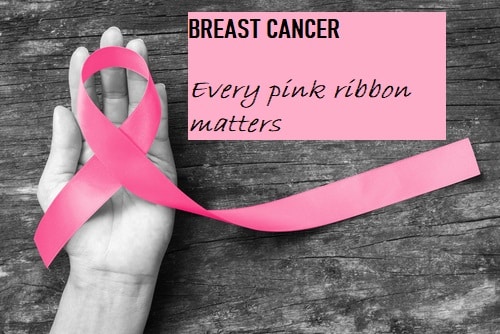As per a study , In every four minutes a woman is diagnosed with breast cancer in India. The incidence of breast cancer has overtaken cervical cancer to become the most common cancer among Indian women. Self Diagnosis is the best prevention from Breast cancer
A. Every Pink Ribbon matters And Cause Difference
From being fourth on the list it has now become the first, among cancers in India during the 1990s. Even today women are not much aware of this serious spread of the disease and are not aware of self diagnosis. In India 75 to 80 percent of women with breast cancer reach a doctor at the advanced stage.
Breast cancer originates in your breast tissue. It occurs when breast cells change and grow excessively, creating a mass of tissue called a tumor which women can feel as a lump around the breast area. Like other cancers, breast cancer can invade and grow into the tissue surrounding your breast. It can also travel to other parts of your body and form new tumors. It’s most likely to affect women over the age of 50. but it can occur at any age.
B. Breast Self-Examination (BSE): Self Diagnosis
It is a self-examination of the breast performed by a woman regularly and repetitively every month.

C. Common Symptoms of breast cancer
Breast cancer symptoms can vary for each person. Here are some common signs of breast cancer one can notice while doing self diagnosis.
i. A change in shape and size of breast — one breast may have become noticeably larger or smaller
ii. A nipple has become inverted (pulled in) or changed its position or shape
iii. Redness of your skin around your breast or nipples
iv. Blood-stained or any abnormal discharge from one or both nipples
- v. Puckering or dimpling of the skin
- vi. A swelling under the armpit or around the collarbone
- vii. A lump or thickening in the breast that feels different from the rest of the breast tissue
- viii. Constant pain in one part of the breast or the armpit.
D. How to reduce your risk of breast cancer?
Many factors throughout a lifetime can influence breast cancer risk. Certain risk factors such as getting older or your family history do not have any control over breast cancer but you can help lower the risk by including the following changes in your life which include:
I. Keeping and maintaining a healthy weight
II. staying physically active- Be physically active for at least 30 minutes a day which lowers the risk of breast cancer.
III. avoiding harmful use of alcohol – Research indicates that drinking alcohol can increase your risk for certain types of breast cancer.
IV. Breastfeeding- breast feed your children if possible, It also has great health benefits for the child
- V. quitting tobacco use and avoiding exposure to tobacco smoke
- VI. avoiding the prolonged use of hormones
- VII. avoiding excessive exposure to radiation
- VIII. following a healthy diet- Try to eat a lot of fruits and vegetables and limit alcohol.
E. How is breast cancer treated?

There are several breast cancer treatment options available including surgery, chemotherapy, radiation therapy, hormone therapy, immunotherapy and targeted drug therapy. The right treatment depends on many factors, including the location and size of the tumor. The stage of your breast cancer also is an important factor in making decisions about your treatment options. In general, the more breast cancer has spread, the more treatment will be needed.
- Surgery for breast cancer– Some treatments, like surgery and radiation treat the tumor without affecting the rest of the body. These surgeries remove cancer as much as possible, find out whether the cancer has spread to the lymph nodes under the arm ,restore the breast’s shape after the cancer is removed and relieve the symptoms of advanced cancer.
- Chemotherapy – chemotherapy uses anti-cancer drugs that may be given directly into your vein or by mouth. The drugs travel through the bloodstream to reach cancer cells in most parts of the body and kill the cancer cells. Sometimes, if cancer spreads to the spinal fluid, which surrounds and cushions the brain and spinal cord, chemo may be given directly into this area.
- Immunotherapy – recognizing and destroying cancer cells by using medicines to boost a person’s own immune system more effectively through medicines. Immunotherapy typically works on specific proteins involved in the immune system to enhance the immune response. These drugs have side effects different from those of chemotherapy.
- Radiation therapy – Radiation is a treatment with high-energy rays that helps in destroying cancer cells. Some breast cancer patients need radiation therapy in addition to other treatments. Depending on the breast cancer’s stage and other factors, radiation therapy can be used in several situations.













